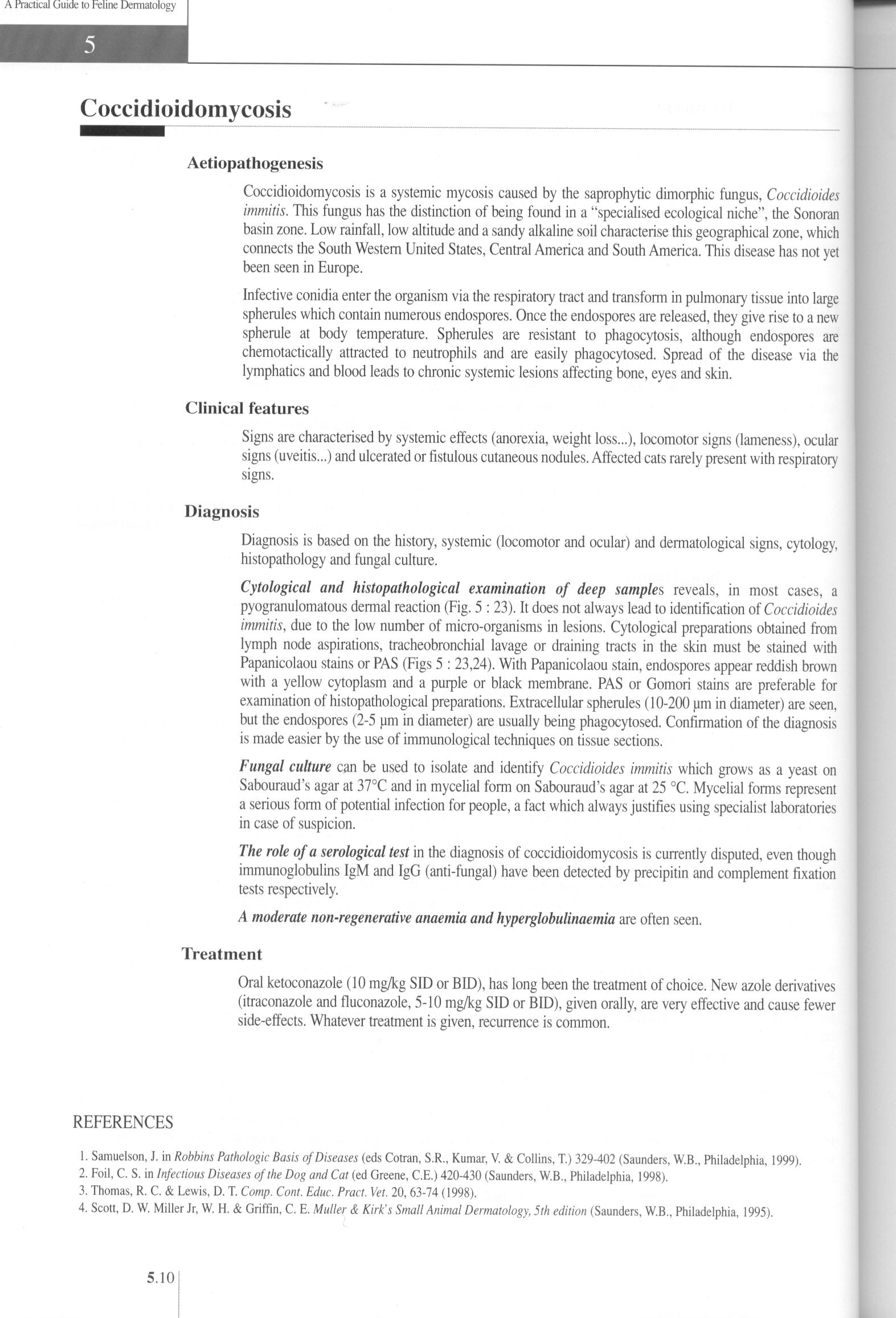510 (5)

A Practical Guide to Feline Dermatology

Coccidioidomycosis
Aetiopathogenesis
Coccidioidomycosis is a systemie mycosis caused by the saprophytic dimorphic fungus, Coccidioides immitis. This fungus has the distinction of being found in a “specialised ecological niche”, the Sonoran basin zonę. Low rainfall, Iow altitude and a sandy alkaline soil characterise this geographical zonę, which connects the South Western United States, Central America and South America. This disease has not yet been seen in Europę.
Infective conidia enter the organism via the respiratory tract and transform in pulmonary tissue into large spherules which contain numerous endospores. Once the endospores are released, they give rise to a new spherule at body temperaturę. Spherules are resistant to phagocytosis, although endospores are chemotactically attracted to neutrophils and are easily phagocytosed. Spread of the disease via the lymphatics and blood leads to chronic systemie lesions affecting bonę, eyes and skin.
Clinical features
Signs are characterised by systemie effects (anorexia, weight loss...), locomotor signs (lameness), ocular signs (uveitis...) and uleerated or fistulous cutaneous nodules. Affected cats rarely present with respiratory signs.
Diagnosis
Diagnosis is based on the history, systemie (locomotor and ocular) and dermatological signs, cytology, histopathology and fungal culture.
Cytological and histopathological examination of deep samples reveals, in most cases, a pyogranulomatous dermal reaction (Fig. 5 : 23). It does not always lead to identification of Coccidioides immitis, due to the low number of micro-organisms in lesions. Cytological preparations obtained from lymph node aspirations, tracheobronchial lavage or draining tracts in the skin must be stained with Papanicolaou stains or PAS (Figs 5 : 23,24). With Papanicolaou stain, endospores appear reddish brown with a yellow cytoplasm and a purple or black membranę. PAS or Gomori stains are preferable for examination of histopathological preparations. Extracellular spherules (10-200 pm in diameter) are seen, but the endospores (2-5 pm in diameter) are usually being phagocytosed. Confirmation of the diagnosis is madę easier by the use of immunological techniąues on tissue sections.
Fungal culture can be used to isolate and identify Coccidioides immitis which grows as a yeast on Sabouraud’s agar at 37°C and in mycelial form on Sabouraud’s agar at 25 °C. Mycelial forms represent a serious form of potential infection for people, a fact which always justifies using specialist laboratories in case of suspicion.
The role of a serological test in the diagnosis of coccidioidomycosis is currently disputed, even though immunoglobulins IgM and IgG (anti-fungal) have been detected by precipitin and complement fkation tests respectively.
A moderate non-regenerative anaemia and hyperglobulinaemia are often seen.
Treatment
Orał ketoconazole (10 mg/kg SID or BID), has long been the treatment of choice. New azole derivatives (itraconazole and fluconazole, 5-10 mg/kg SID or BID), given orally, are very effective and cause fewer side-effeets. Whatever treatment is given, recurrence is common.
REFERENCES
1. Samuelson, J. in Robbins Pathologic Basis of Diseases (eds Cotran, S.R., Kumar, V. & Collins, T.) 329-402 (Saunders, W.B., Philadelphia, 1999).
2. Foil, C. S. in lnfectious Diseases ofthe Dog and Cal (ed Greene, C.E.) 420-430 (Saunders, W.B., Philadelphia, 1998).
3. Thomas, R. C. & Lewis, D. T. Comp. Cont. Educ. Prąd. Vet. 20,63-74 (1998).
4. Scott, D. W. Miller Jr, W. H. & Griffin, C. E. Muller & Kirk's Smali Anirnal Dermatology, 5th edition (Saunders, W.B., Philadelphia, 1995).
Wyszukiwarka
Podobne podstrony:
67 (125) 6 A Practical Guide to Feline DermatologyNocardiosisAetiopathogenesis Nocardiosis is a very
33 (337) 3 A Practical Guide to Feline DermatologyCheyletiellosisAetiopathogenesis Cheyletiellosis i
252 (18) 25 A Practical Guide to Feline DermatologySporotrichosis Sporotrichosis is a deep mycosis,
69 (119) 6 A Practical Guide to Feline DermatologyDiagnosis The diagnosis is based on lesion distrib
74 (105) 7 A Practical Guide to Feline Dermatology ulcerated. Lesion distribution is multicentric bu
31 (328) 3 A Practical Guide to Feline Dermatology Sarcoptic mange Sarcoptes scabiei var canis (Tabl
44 (228) 4 A Practical Guide to Feline Dermatolog) The term “asymptomatically infected cat” refers
37 (248) 3 Practical Guide to Feline DermatologyDiagnosis The diagnosis is based on finding these 6
58 (148) 5 A Practical Guide to Feline Dermatology severity of the illness. High titres are seen wit
65 (127) 6 A Practical Guide to Feline Dermatology Other topical antimicrobial agents, such as chlor
710 (2) 7 A Practical Guide to Feline DermatologyHerpesvirus infections Dermatological manifestation
27 A Practical Guide to Feline Dermatology Perianal glands 1.7 Permethrin 3.12, 3.13 Persian 1.6,2.2
27 A Practical Guide to Feline Dermatology Stemphyllium spp. 5.1,7.8 Stereotypie behaviour 17.1,
272 (16) 27 A Practical Guide to Feline Dermatology Alternaria spp. 5.1,7.8 Aluminium hyroxide 15.6&
274 (18) 27 A Practical Guide to Feline Dermatology Colitis 11.2 Collagen 1.2,2.6,12.1,
278 (17) 27 A Practical Guide to Feline Dermatology I J Histoplasmosis 5.8, 7.8, 25.2 Homer’s syndro
28 (374) 2 A Practical Guide to Feline Dermatology Configuration of lesions Determining the configur
313 (14) A Practical Guide to Feline Dermatology The second phase consists of long-term control of t
82 (128) 8 A Practical Guide to Feline Dermatology considered important parasites. Cats in the Unite
więcej podobnych podstron